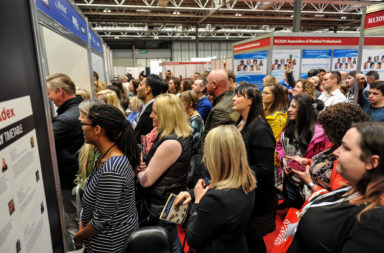We often associate blades and other highend sports prostheses with prestigious events like the Paralympics. But how can ordinary disabled people get hold of sports prosthetics?
To many of us, sports prostheses like blades and running legs, appear the domain of elite para-athletes rather than ordinary sports enthusiasts. And yet a good sports prosthetic can be life-changing for amputees, making it easier to stay healthy, engage in leisure activities, and achieve personal ambitions.
You don’t need to be a Paralympian to use a sports prosthesis. There are challenges involved, both physical and financial, but many ways around them.
Footing the bill
Sports prosthetics are not cheap. According to LimbPower, a charity that works to engage amputees in sports, physical activities and the arts, a running blade might set you back about £1,300. However, there is funding available to help cover the costs of expensive sports prostheses. In November, the Department of Health announced £1.5 million of sports prosthetics funding for young people aged up to 18 years, to encourage them to stay active and healthy. The funding is capped at £5,000 per limb, and limb centres can forward applications until March 2018.
Renowned prosthetics manufacturer, Ottobock welcomed the announcement, encouraging parents to “Act fast” to apply for funding for sports prostheses for their children. Ottobock’s Managing Director, Philip Yates, said that the grant “Goes some way to ensure children with limb amputation or congenital limb deficiency can lead healthy and active lives.”
Lauren Beaty, also of Ottobock, told Able Magazine that “There are no similar funds for adults at present,” and that sports prostheses for adults are “Usually sourced on a case-by-case basis and via private funding.”
One potential source of funding for adults interested in buying a sports prosthesis is Arctic One, a charity that provides grants to disabled athletes to help them with the cost of sports equipment. Their Forward Motion grants, of up to £500, helped 19 athletes last year.
Learning to take part in sports with a prosthetic limb can be physically as well as financially, challenging. But as Able learned when we spoke to amputees involved in sports, there are many sources of support available, and many different ways around the obstacles to getting active.
Chris and Denise Arthey have long been keen on sports: Denise played netball at university, and the couple used to play tennis and badminton together after they met. In his forties, Chris became interested in endurance sports after taking part in a charity race at work, and began competing in marathons.
Amputees
In 2008, Chris and Denise were on holiday in Texas when an accident put all these interests on hold. They were motorcycle touring on a Harley-Davidson when a drunk driver swerved into their lane, hitting them almost head on. Everyone involved in the crash was severely injured, and Chris and Denise had to have their left legs amputated above the knee.
When she learned that Chris’ leg needed to be amputated, Denise assured the surgeon that he would race again. “Losing a limb doesn’t change who you are,” she told Able. “Chris had that athlete in him,” and she knew that nothing would change that fact.
After months of gruelling physiotherapy, Chris and Denise began talking to prosthetics companies and considering their options. They spoke with three different prosthetists, finally choosing the one who agreed he would try to get Chris racing again.
He called in Francois Van Der Watt, Oscar Pistorius’ prosthetist, to put together a running leg for Chris. Chris tried it out, and was able to run on it within a few minutes. Just as Denise had predicted, a year and a half after the accident, Chris was ready to try running again.
Learning
It was a steep learning curve. Chris’s first running leg had an articulated (bending) knee, which meant that it had to be fully extended every time his foot hit the ground to prevent the possibility of collapse.
Chris was out of condition and he had to concentrate on every step. “I could only run for a few yards before I was completely puffed out” he commented, “And I was falling over a lot”. After a year, Chris switched to a pylon leg, which doesn’t bend at the knee, and found that it made things much easier. Since then, Chris has completed two marathons, and with the acquisition of a cycling leg as well, he has also competed in three Olympic-distance triathlons. Last year, he climbed Mount Kilimanjaro.
Chris’s experience is proof that losing a limb need not stop you from participating in a huge variety of sports. It has to be said that the prostheses he and Denise use are not cheap. As expats in the USA, the couple had excellent medical insurance at the time of the accident, which covered their treatment and prostheses. Chris told Able that the cost of sports prostheses “Can be quite a barrier to overcome” for those on low incomes. But not all of Chris and Denise’s sporting activities require expensive equipment. They both swim without prostheses, for example. “It’s easiest just to swim with one leg,” Denise commented, though Chris noted that this can cause some problems: “I can swim breast stroke,” he explained, “but every time I kick, I turn left. Freestyle works better.”
So what advice would they give to amputees looking to get involved in sports? “Get inspired by someone else who’s already doing it,” says Denise.
Decisions
Like Chris and Denise, Hannah Moore is a sports enthusiast and an amputee. After a routine procedure to remove an ingrown toenail in 2012, she developed Complex Regional Pain Syndrome (CRPS) in her right foot. The CRPS caused swelling, ulcers, and severe pain, and for two years, Hannah was unable to walk at all. In 2016, she made the decision to have her right leg amputated below the knee.
Hannah is a keen sportswoman with a black belt in karate, and she was determined to continue her physical activities after her amputation. She now competes in triathlons and continues to train in karate, all using the standard walking leg provided to her by the NHS. Hannah argues that expensive sports prostheses are not necessary to enjoy recreational sports. “I think it’s possible to do almost any sport with a standard NHS leg,” she told Able. “I do karate and triathlon, but I know others who do other sports too.” The NHS gave Hannah a carbon fibre foot to make participating in sports easier, but haven’t been able to provide her with a dedicated sports prosthesis.
Hannah is not letting this hold her back, and has been raising money to buy a running blade and a specialist cycling leg for herself. Her fundraising efforts have included a GoFundMe page, grants from Arctic One and her local council’s sports grant system, and a fundraising chain where para-athletes help each other to raise money for sports equipment. Though she is content to use her NHS prosthesis for recreational sport, as a Paralympic hopeful, Hannah feels that a move to using dedicated sports prostheses is essential for her career. “I am competing at a reasonable level in my triathlons,” she said, “but to get on to an elite team I need a running blade to enhance my performance.”
Hannah’s advice to other amputees who want to get into sport is to “Get out and do it. There really are no barriers. Join your local club, whether it be an able bodied or disability club,” she said. “You do not need this expensive kit to start with and it really won’t give you the benefi ts unless you’re already doing the activity as best you can with what you have.”
Whether you opt to take part in sports with a standard NHS limb, or buy or raise money for a dedicated sports prosthesis, the stories of Chris, Denise and Hannah show that there are many different routes into sports if you’re an amputee. What all three athletes agree on is that whatever you choose to do, you’re not alone. Getting in touch with other athletes, both able bodied and disabled, can give you a network that can motivate, support, and even fundraise to help you achieve your sporting dreams.
As Chris Arthey puts it: “If you can fi nd an amputee out there who has been there and done that and who can give you hope, who knows what you can achieve?”
More:
LimbPower: www.limbpower.com
Arctic One: www.arctic1.co.uk
GoFundMe: uk.gofundme.com
Chris and Denise Arthey’s website:
Hannah Moore’s website:
www.imstumpedcrps.wordpress.com
Ottobock: www.ottobock.co.uk
Blatchford: www.blatchford.co.uk



